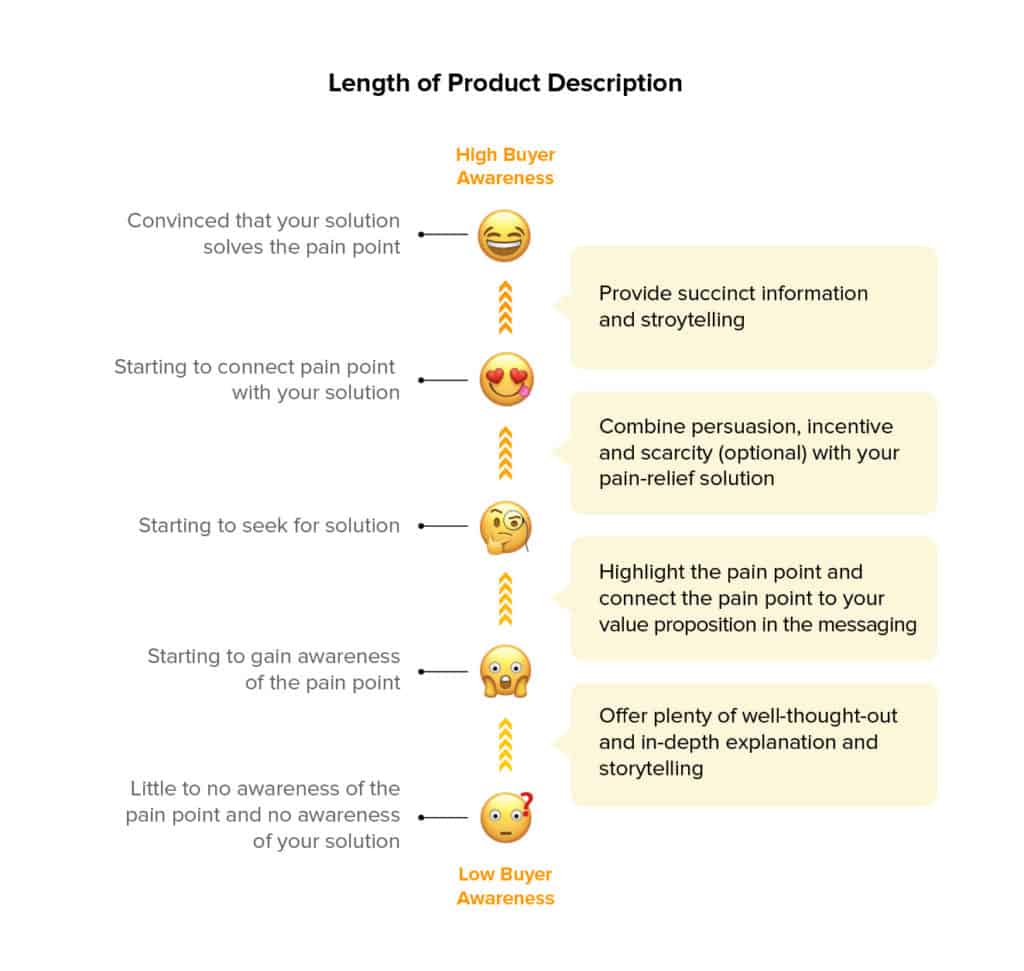When it comes to securing conversions, it doesn’t matter how beautiful your website is, how slick your templates are, or how poetic your descriptions sound – if no one can find your products or services online, then no one will be able to buy them.
Sure, there’s paid search – but that’ll only get you so far. According to LinkedIn, the average click-through-rate for paid search is a mere 4.1% – not really enough to consistently fatten up that bottom line. What online conversion success really comes down to is whether your product descriptions are search engine optimisation (SEO) friendly. Unlike paid search, SEO is a long-term strategy that will give your product descriptions a vital edge in the competitive, crowded market of ecommerce.
What Is A Product Description?
A product description is the marketing copy that describes your product or service, and highlights why a potential customer might want to buy it. It can include the name of the product, the features, benefits, the price – all the things customers will consider when comparing products online and making a final purchase decision.
Why Do We Need SEO-Friendly Product Descriptions?
Product descriptions can be an invaluable tool to help build an online presence for your brand – ensuring you have a competitive product that stands as both a solution to a customer’s problem with marketable unique selling points (USPs), and also as an SEO-friendly asset that is easily discovered.
The whole point of search is to help customers find exactly what they’re looking for – and a good product description can play a key part in that journey. SEO has been found to be 5.66 times more effective than paid search ads, with 70-80% of the search engine users focusing solely on organic results.
The key to writing good product descriptions that both Google and your customers can find and understand is to use the right keywords while doing away with irrelevant phrases and content. If your product descriptions are meeting a real need and using relevant keywords, then you’ll be in Google’s good books and rank well in search.
Here’s How To Optimise Your Product Descriptions
1. Write For Searchers, Not Search Engines
It’s essential that your descriptions help your customer and speak to their needs. The key thing to remember is that you want your products to be found by real humans, looking for real solutions to a defined problem. Not alien life forms. Not unicorns.
Put yourself in your customers’ shoes – or rather their keyboards. What will they be searching for? What keywords will they be likely to use? Any description copy you include should inform, excite, and, ultimately, encourage people to make a purchase.
A good place to start is to shape your copy around key customer centric questions: Who, What, When, Why, and How. Search engines like Google reward usability – so if you consistently take a buyer-centred approach, you’ll be well on your way to writing SEO-friendly product descriptions.
2. Link Product Benefits To Emotion
As with any sales and marketing strategy, product descriptions work best when they make your audience feel something and connect your product on an emotional level. You can do this by linking emotions with the features and benefits of your product.
This means you’ll need to really, really understand the product and all its unique selling points (USPs). If you only have a vague idea of what you’re selling, you’ll end up writing vague, fluffy product descriptions that are unhelpful, uninspiring, and ultimately a waste of precious SEO potential.
Try basing your descriptions on these key content pillars: Design, Feature and Emotion:
- Design is the visible elements that make up your product, such as the colour, shape, or fit.
- Features are invisible – it’s what the product can do and how it works, such as a lightweight waterproof jacket.
- Emotion is arguably the most important part of a description. This is where you need to link unique human needs with the benefits of the product. Highlight exactly how the product features will work for the buyer. For example, how will the product improve the buyer’s life? How will it solve a problem? How will this make your customer feel?
3. Find The Right Words
If you want your products to be easily found by customers, you’ll need to strategise and target the right keywords. These are some tips you can use to find the perfect words:
- Keyword tools: Keyword tools like SEMrush can provide you with useful insights like search volume, keyword difficulty and related terms. This can be especially handy for identifying the golden ticket of search terms – long-tail keywords, such as “Size 12 pink knitted jumper with unicorn”. These kinds of terms have less search volume and competition, but a higher intent of purchase, meaning you’ll be far more likely to make a sale if your keywords match up.
- Data insights: Google Analytics is endlessly helpful for optimising your product descriptions to drive more search traffic. Data, just like Shakira’s hips, doesn’t lie – so use it to strengthen and guide your SEO strategy whenever you can. With insights on search rankings, click through rates, search intent and more, you can analyse data to inform your product description strategy, map out important keywords, and boost conversion rates.
Remember: Avoid keyword stuffing – filling a webpage with a bunch of out-of-context keywords in an attempt to rank higher in Google search results. This is an outdated SEO tactic that’s now considered anti-user-friendly by search engines, and will likely result in a lower ranking for your website.
4. Be Aware Of Buyer Awareness
So what’s the perfect length for a product description? While the general rule of thumb favours short, concise descriptions, there is no set length that works for every product. Instead, best practice demands that you base the length of your descriptions on what your customer needs. Let buyer awareness drive the product description length:

As a minimum, content should be 300 words and above to avoid thin content issues that don’t provide search engines (or your customers) with enough semantic information.
When telling your product story, remember to consider the expected level of buyer awareness.
Low Buyer Awareness: Customers with little to no knowledge of your product will need more convincing – they have no idea who you are, what your product is, or why they have a need for it. This means you’ll need to describe your product thoroughly to bring them to the level of awareness needed for a purchase.
High Buyer Awareness: Well-researched or loyal customers will already know your product and why they need it. Because of this, they’ll require far less convincing to make a purchase, so you can keep your copy short, sweet, and to-the-point.
5. Create Unique Content
While it’s important to hit popular keywords in your description, you should also make an effort to be original in your content and avoid duplicate content at all costs. According to Moz, when product descriptions are too similar, search engines react poorly to them, driving down the SEO rankings on all of your pages. To ensure this doesn’t happen to you, create product titles and descriptions that are varied and unique.
Tip: Try the template / Frankenstein method. Create a list of USPs, designs, features, and emotions / benefits. Then mix-and-match for quick, easy, original content. While this requires a lot of groundwork to begin with, it’s well worth the time spent compared to writing everything from scratch.
6. Measuring Your Path To Success
Writing SEO-optimised product descriptions is an ever-evolving project that will require a test-and-learn approach. Over time, you might need to use a different tone of voice to drive conversions, or include more product features in your copy.
It’s important to set goals and key performance indicators (KPIs) from the start in order to properly measure your success and refine your approach. Stay on top of the latest trends in your industry and work to highlight these in your descriptions. Keep an eye on your competitors’ product descriptions to see what you’re up against. Find what works for you and your customers and avoid getting complacent.
Uncovering New Opportunities
While writing product descriptions for your ecommerce business might seem like a daunting process, the benefits are well worth it. Once you’re setup with a collection of unique, relevant and emotive product descriptions, you’ll be sure to see a range of benefits – from a decrease in cart abandonment and product return rates, to a boost in organic search rankings and conversions. Of course, you don’t have to tackle this alone.
If you’d like help in shaping your digital marketing strategy, harnessing data analytics, or driving your SEO growth, get in touch with the Yoghurt Digital team today to chat. We believe in telling it like it is, so we refuse to use a one-size-fits all template solution for every business. We’ll take the time to study your unique business and products and work on having honest conversations to uncover the best opportunities possible.

